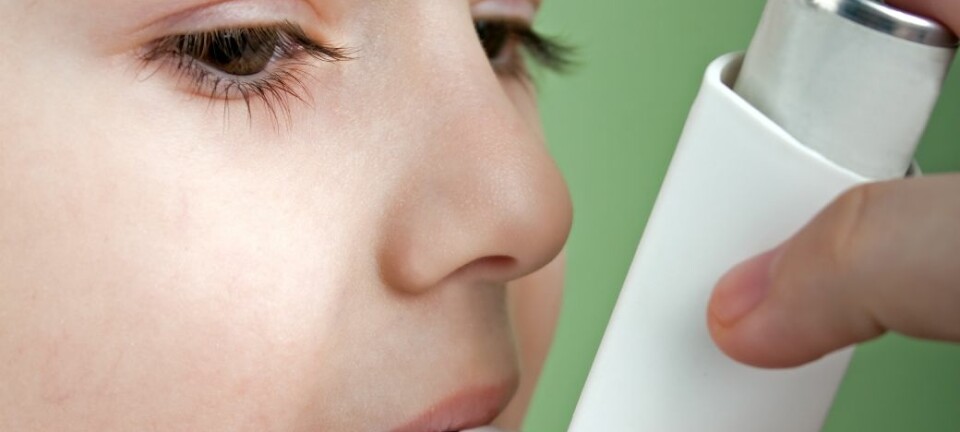
Air pollution hospitalises small children
Rising numbers of small children are hospitalised with asthma when air pollution increases, new study shows. One surprising finding is that ultra-fine particles from road traffic play only a little role.
Breathing can be difficult when you’re lying in your pram or playing in your kindergarten and there’s a lot of air pollution.
For some small children, this pollution brings on asthma attacks so bad that they must be sent to hospital for help.
On average, 10 percent more children are hospitalised on days with high air pollution than on days with low air pollution.
This is one result of a Danish study of 8,226 small children and youngsters who were admitted to hospitals in Copenhagen because of asthma. The study is the first to correlate the number of hospitalisations with air pollution measurements in the children’s hometown.
Air pollution comes from many other sources than cars. Medium-sized and large particles in particular come to Denmark from the Ruhr industrial district in Germany and from Poland. Our study shows that traffic is not the greatest problem for asthma sufferers.
Hans Bisgaard
“We’ve used some very advanced statistical methods which have given our study very high solidity and credibility,” says Hans Bisgaard, the head of the Danish Pediatric Asthma Center at Copenhagen University Hospital in Gentofte and a professor of paediatrics at the University of Copenhagen.
“There is a very clear correlation between air pollution in Copenhagen and hospital admittances for treating asthma in Copenhagen children a couple of days later.”
Ultra-fine particles less damaging than expected
The study was carried out in collaboration with researchers from the Danish Cancer Society and the Danish Centre for Environment and Energy, part of Aarhus University. It gives the first credible figures for the number of hospitalisations for asthma due to air pollution – but it also shows another, highly surprising result:
The number of hospitalisations rises in line with the gases and medium-sized particles in the air – which typically come from industrial areas in countries south of Denmark – but hospitalisations do not rise when there are more ultra-fine particle in the air.
This result surprises experts because the ultra-fine particles – typically arising from the exhaust of diesel-powered vehicles or locally from wood-burning stoves – are viewed as the cause of blood clots, cardio-vascular diseases and lung cancer. At the same time, experts have held the view that ultra-fine particles easily find their way deep into children’s lungs and hamper their breathing.
“There will undoubtedly be a number of experts who will be infuriated by this result as we have so far had the rather mechanistic view that small particles cause the most damage in the form of asthma, because they penetrated so deeply into the airways,” says Bisgaard.
“Now they may have to consider whether it is easy to exhale the small particles from the lungs again, or whether the particles must have a certain weight in order for them to remain in the lungs and cause damage – but for the moment that’s pure speculation.”
Traffic still a problem
Although traffic is a smaller than expected source of asthma attacks, traffic has not been ruled out as a source of illnesses. Diesel exhausts contain the gases NO and NO2, otherwise known as NOx, and this study shows that a high content of NOx in the air seems to correlate with an increase in hospitalisations.
At Astma-Allergi Danmark, which works to improve the everyday lives of people suffering from asthma, eczema and allergies, researchers are glad that the study confirms that NOx gases are harmful and that children’s lungs are especially at risk.
However, biologist Janne Sommer is surprised that ultra-fine particles appear to play a smaller role.
“It’s a very interesting study that has different results from previous studies,” she says.
“But we still don’t know enough about ultra-fine particles, so there’s a need for more research before we can say anything definite about their effects.”
For example, she adds, it would be interesting to have studies that make allowances for how many ultra-fine particles the individual test person has been subjected to – to a greater extent than when measurements from a single measurement unit are used.”
Asthma research builds on unique Danish data
In the study, the researchers focused on children, since children seem to be more affected by air pollution than adults, partly because the children:
- Are in the process of developing their lungs and immune system
- Inhale more particles because they have a higher respiration rate and breathe through their mouths
- Are generally more active in day-care institutions and in sports activities in localities with high air pollution
The conclusions build on unique Danish data – such as registration of all hospital admittances for asthma at eight Copenhagen hospitals in 2001-2008 among children living within a radius of 15 km from the measurement station used in the study.
The results have been published in the scientific journal Thorax.
----------------------------------------
Read this article in Danish at videnskab.dk
Translated by: Michael de Laine













